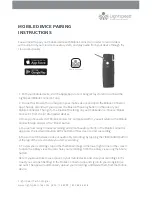
180 Managing virtual fabrics
Figure 18
Logical Fabric using ISLs and XISLs
By default, the physical ISL path is favored over the logical path (over the XISL) because it has a lower cost.
This behavior can be changed by configuring the cost of the dedicated physical ISL to match the cost of the
LISL.
Base switch ports on different chassis can be connected together to form a base fabric. Similar to other
Logical Switches, the base switches must have the same FID to be connected to one another. If the base
switches have different fabric IDs, the link between the switches is disabled.
It is a good practice to configure at least two XISLs, for redundancy.
The base fabric follows normal routing policies. As long as physical connectivity is available, the base
fabric maintains connectivity for the Logical Fabrics.
NOTE:
If you disable a base switch, all of the logical ISLs are broken and the Logical Switches cannot
communicate with each other unless they are connected by a physical ISL.
Logical Fabric formation
Fabric formation is not based on connectivity, but is based on the FIDs of the Logical Switches. The basic
order of fabric formation is as follows:
1.
The base fabric forms.
2.
Logical Fabrics form when the base fabric is stable.
3.
Traffic is initiated between the Logical Switches.
4.
Devices start seeing each other.
Management model for Logical Switches
A Virtual-Fabrics-capable chassis is managed as a set of Logical Switches, not as a single switch.
There is one common IP address for the hardware that is shared by all of the Logical Switches in the
chassis.
All user operations are classified into one of the following:
•
Chassis management operations
These are operations that span Logical Switch boundaries, such as:
• Logical Switch configuration (creating, deleting, modifying Logical Switches)
• Account management (determining which accounts can access which Logical Switches)
• FRU management (
slotShow
)
Base switch
Fabric ID 8
P9
Logical switch 7
Fabric ID 15
P7
Logical switch 6
Fabric ID 1
P4
Physical chassis 2
Base switch
Fabric ID 8
P6
Logical switch 3
Fabric ID 15
P5
Logical switch 2
Fabric ID 1
P2
P1
Physical chassis 1
P8
P6
P2
P1
XISL
Logical ISL
Logical ISL
Logical ISL
ISL
Logical switch 1
(Default logical switch)
Fabric ID 128
Logical switch 5
(Default logical switch)
Fabric ID 128
Summary of Contents for A7533A - Brocade 4Gb SAN Switch Base
Page 1: ...HP StorageWorks Fabric OS 6 2 administrator guide Part number 5697 0016 Edition May 2009 ...
Page 24: ...24 ...
Page 99: ...Fabric OS 6 2 administrator guide 99 ...
Page 100: ...100 Managing user accounts ...
Page 118: ...116 Configuring standard security features ...
Page 164: ...162 Configuring advanced security features ...
Page 234: ...232 Installing and maintaining firmware ...
Page 268: ...266 Administering advanced zoning ...
Page 284: ...282 Configuring Enterprise class platforms ...
Page 292: ...290 Routing traffic ...
Page 294: ...292 Interoperability for merged SANs ...
Page 302: ...300 Configuring the Distributed Management Server ...
Page 334: ...332 iSCSI gateway service ...
Page 340: ...338 Administering NPIV ...
Page 407: ...Fabric OS 6 2 administrator guide 405 ...
Page 408: ...406 Using the FC FC routing service ...
Page 438: ...434 Administering extended fabrics ...
Page 460: ...456 Administering ISL trunking ...
Page 516: ...512 FICON fabrics ...
Page 526: ...522 Configuring and monitoring FICON Extension Services ...
Page 540: ...536 Configuring the PID format ...
Page 544: ...540 Understanding legacy password behavior ...
Page 546: ...542 Mixed fabric configurations for non merge SANs ...
Page 550: ...546 Migrating from an MP Router to a 400 MP Router ...
Page 558: ...554 Inband Management ...
Page 572: ...568 ...
















































